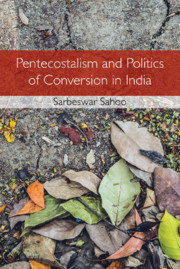Book contents
- Frontmatter
- Contents
- Foreword
- Preface
- Abbreviations
- 1 Introduction: Conversion and the Shifting Discourse of Violence
- 2 Spreading Like Fire: The Growth of Pentecostalism among Tribals
- 3 Taking Refuge in Christ: Four Narratives on Religious Conversion
- 4 Becoming Believers: Adivasi Women and the Pentecostal Church
- 5 Seen as the Alien: Hindutva Politics and Anti-Christian Violence
- 6 Conclusion: Beyond the Competing Projects of Conversion
- Endnotes
- Bibliography
- Index
2 - Spreading Like Fire: The Growth of Pentecostalism among Tribals
Published online by Cambridge University Press: 05 April 2018
- Frontmatter
- Contents
- Foreword
- Preface
- Abbreviations
- 1 Introduction: Conversion and the Shifting Discourse of Violence
- 2 Spreading Like Fire: The Growth of Pentecostalism among Tribals
- 3 Taking Refuge in Christ: Four Narratives on Religious Conversion
- 4 Becoming Believers: Adivasi Women and the Pentecostal Church
- 5 Seen as the Alien: Hindutva Politics and Anti-Christian Violence
- 6 Conclusion: Beyond the Competing Projects of Conversion
- Endnotes
- Bibliography
- Index
Summary
The secularisation hypothesis, which predicts the decline or privatisation of religion with the spread of modernity and techno-scientific rationality, has been defied in the Asian context (Hefner, 1998; Joas, 2007; Schulz, 2006). There seems to be a religious resurgence in Asia (Hefner, 2010), particularly in India with the rise of Pentecostal Christianity among the tribals, along with the rise of Hindu nationalism. Although Christianity was first brought to India by Saint Thomas, the Apostle, in AD 52, it remained confined to Kerala. It was only during colonialism, first by the Portuguese and then by the British, that Christianity began to spread to other parts of the country. The meanings, patterns and modes of conversion of the native population to Christianity were quite varied and complex (Clarke and Robinson, 2003: 1–21; Yang, 1998: 240). Today, anywhere between 2.3 and 6 per cent (24 to 68 million people) of the Indian population are Christian (Mosse, 2012: ix) and are found predominantly in Kerala and Tamil Nadu as well as Goa and the north-eastern states of India.While two-third of India's Christians are Catholics, Protestants are also a very influential group and belong to diverse traditions such as Baptist, Brethren, Methodist, Presbyterian, Anglican, Congregational and others.
While Pentecostalism belongs to Protestantism, its theological doctrine and rapid growth has established it as a unique denomination. Although commentators in secular Western Europe have dismissed it as ‘a backward cargo cult’, Pentecostalism today is the fastest growing denomination within Christianity and it is ‘spreading like fire’ for which many observers see it as ‘a major wave for the future’ (Martin, 2011: 63– 64 ; Meyer, 2010: 118). As Anderson (2010, 13) notes, ‘Pentecostalism in all its diversity, both inside and outside the older churches, was probably the fastest expanding religious movement worldwide in the twentieth century, and by the beginning of this century it had expanded into almost every nation on earth’. A 2004 data source points out that there are 135 million Pentecostals/Charismatics in Asia, 80 million in North America, 141 million in Latin America, 126 million in Africa and 38 million in Europe (Anderson, 2004: 123).
- Type
- Chapter
- Information
- Pentecostalism and Politics of Conversion in India , pp. 21 - 48Publisher: Cambridge University PressPrint publication year: 2018



